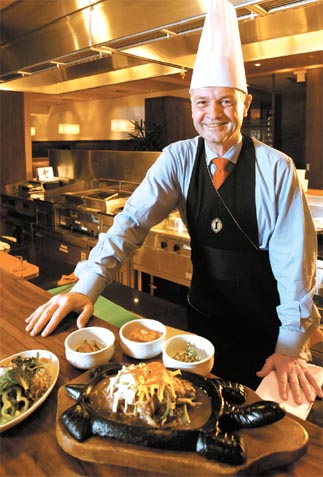Easy and delicious, like Korean stroganoff

Juergen Woehler stands proudly over his bulgogi at the COEX InterContinental Seoul hotel. By Oh Sang-min
Standing over the wok was Juergen Woehler, 60, secretary general and executive director of the Korean-German Chamber of Commerce and Industry, sprinkling sesame seeds on top of the sizzling beef. He decorated the dish by adding a garnish of thinly-fried yellow and white egg.
Gazing down at his culinary masterpiece - made together with the hotel’s chef, Ahn Seung-hee - Woehler looked pleased.
It was the culmination of more than an hour spent slicing tenderloin into thin layers and trimming away the fat. Woehler also cut fresh mushrooms and onions, mixing them together with a special sweet sauce made from soy sauce, chopped garlic, black pepper and other ingredients.
In between adding ingredients to the sauce, Woehler constantly tasted it. If it didn’t suit his palate, he would ask the chef to add “a bit more water,” or “put in more soy sauce” or even “add some white wine,” instead of the rice wine that is normally put inside the sauce to cut through the scent of the beef.
“Bulgogi seems to be a popular dish especially among foreigners because the taste isn’t that spicy like other Korean dishes such as kimchi jjigae [kimchi stew] or ojingeo bokkeum [stir-fried squid],” Woehler said. Too much gochujang chili paste can overwhelm the genuine flavor of the ingredients, he warned.
Bulgogi, on the other hand, is not a “one-sided or one-flavored dish” but has a multitude of flavors and ingredients, Woehler said. For example, each ingredient used to marinate the beef has a different flavor - salty soy sauce, sweet sesame oil, sugar or honey and spicy garlic and onions.
The German businessman first tasted bulgogi in 1985, during a two-year stay in Korea as the director of the investment and legal department for the Korean-German chamber that he has now led since 2007. The organization is currently the second-largest national chamber in Korea, with 462 members. Before arriving in Seoul in the 1980s, Woehler served as a representative with the federal government in Bonn. He was also an attorney at law and junior lawyer in Stuttgart, Germany, after receiving a degree in comparative law at the University of Strasbourg in France in 1978.
When he first lived in Korea, Woehler enjoyed traveling across the country and explored regional tastes. It was during one of these culinary adventures in 1985 near the Namdaemun area, central Seoul, that Woehler met the Korean woman he would marry the following year. He called it “love at first sight.” And as his love for his wife grew, so did his affection for Korean cuisine.
“When I returned back to Germany, this time with my wife, I started cooking Korean specialties for her,” he said. One of them was bulgogi. “All the ingredients, like meat, garlic, onions, were there at local supermarkets, and sesame oil and soy sauce were available at Asian shops. It was very simple to make.”
The fact that the ingredients for making bulgogi can be easily acquired even in other countries, Woehler said, means it might be introduced globally more easily than other, more complicated dishes. Especially in Germany, where people are open-minded about tasting other cuisines, bulgogi could be a big hit, Woehler said. There’s even a Russian dish similar to bulgogi that’s popular in Germany - beef stroganoff, a meat dish served with sour cream sauce.
While washing the lettuce and sesame leaves that would be served alongside the beef, Woehler offered more ideas on promoting not only bulgogi but also Korean food in general.
“As to marketing vis-a-vis foreigners, I recommend to focus on only a few dishes with easy recipes, like three different starters and three main dishes,” he said enthusiastically. “A full-fledged Korean meal with 10 side dishes looks wonderful on the table but might deter foreigners from trying to cook by themselves, because it might seem too complicated and too laborious for a beginner.”
For him, bindaetteok (mung-bean pancakes), bibimbap (steamed rice mixed with fried vegetables) and bulgogi would be the most “obvious” dishes to gain international acceptance as mains, while gimbap (seaweed rolls), miyeokguk (seaweed soup) or jeon pancakes would be better as appetizers. Bindaetteok in particular has counterparts in other countries, Woehler said, but he hasn’t seen kimchi or herbs inside any of those non-Korean dishes.
“In any case, Korean food should be marketed with the proper Korean name at least written in brackets, and the lack of obesity in Korea due to light Korean food should be emphasized as well,” he said.
Juergen Woehler
*Secretary general and executive director, Korean-German Chamber of Commerce and Industry
*Attorney at law; arbitrator on the Korean Commercial Arbitration Board; member of the Invest Korea, Advisory Council and the Seoul Foreign Investment Advisory Council
*From 1987-2007, served as executive vice president at the Landesbank Baden-Wuerttemberg, Stuttgart
*From 1985-1987, served as director of the investment and legal department at the Korean-German Chamber of Commerce and Industry
By Lee Eun-joo [angie@joongang.co.kr]










with the Korea JoongAng Daily
To write comments, please log in to one of the accounts.
Standards Board Policy (0/250자)